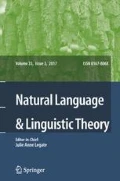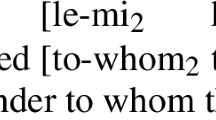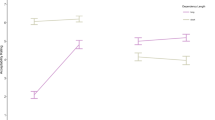Abstract
We present a series of large-scale formal acceptability judgment studies that explored Norwegian island phenomena in order to follow up on previous observations that speakers of Mainland Scandinavian languages like Norwegian accept violations of certain island constraints that are unacceptable in most languages cross-linguistically. We tested the acceptability of wh-extraction from five island types: whether-, complex NP, subject, adjunct, and relative clause (RC) islands. We found clear evidence of subject and adjunct island effects on wh-extraction. We failed to find evidence that Norwegians accept wh-extraction out of complex NPs and RCs. Our participants judged wh-extraction from complex NPs and RCs to be just as unacceptable as subject and adjunct island violations. The pattern of effects in Norwegian paralleled island effects that recent experimental work has documented in other languages like English and Italian (Sprouse et al. 2012, 2016). Norwegian judgments consistently differed from prior findings for one island type: whether-islands. Our results reveal that Norwegians exhibit significant inter-individual variation in their sensitivity to whether-island effects, with many participants exhibiting no sensitivity to whether-island violations whatsoever. We discuss the implications of our findings for universalist approaches to island constraints. We also suggest ways of reconciling our results with previous observations, and offer a systematic experimental framework in which future research can investigate factors that govern apparent island insensitivity.






Similar content being viewed by others
Notes
One possibility—for many, but not all of our experiments—would be to extract indirect objects from matrix and embedded clauses. We encourage future researchers to conduct this comparison if they are concerned about the potentially confounding effect of grammatical role discrepancies.
The observant reader will note that the complement of the noun nyheten (‘the news’) is a PP, headed by om (‘about’), rather than a bare CP, as in English. Clausal complements to N must always be wrapped in a PP (see Lødrup 2004), thus this difference from the English examples is unavoidable.
Given that the subject island effects that we observed are relatively large, an experiment that tested the Norwegian equivalent of (13) would serve as an excellent cross-validation. We expect that the subject island effect should be large enough to survive the filled-gap effect and the potential floor effect of the design in (13). We leave such a validation to future research.
Some authors have proposed that only subject RCs allow extraction (Platzack 2000; Kush et al. 2013), but this has been disputed (Engdahl 1997; Lindahl 2014). It was also initially proposed that indefiniteness is a necessary condition for acceptable RC extraction, but this claim is contradicted by some attested examples (Maling and Zaenen 1982; Engdahl 1997).
An appendix containing all test and filler materials, as well as by-item summary statistics for filler items have been included as Supplementary Materials.
We found no consistent age, gender, or dialect differences between groups of accepters and rejecters.
The account was initially designed to explain the ability to extract from RCs. We return to this point later.
Of course, this claim merits more rigorous experimental verification so that the comparison with our results would be appropriate.
Miyagawa (2004), building off Beck’s (1996) notion of a Quantifier Induced Barrier, argues that scope intervention effects emerge when a wh-phrase is separated from its restrictor by a scopal operator (such as whether). ‘Referential’ wh-phrases—which Miyagawa terms ‘presuppositional’ following Cresti (1995), Beck and Kim (1997), and others—avoid scope intervention because their restrictors are interpreted ‘high’ above the intervener. Under this implementation, variable scope intervention effects track whether participants adopt a presuppositional/non-presuppositional reading of the wh-phrase, because this choice determines the position of the wh-phrase’s restrictor at LF. Under this approach, the variability that we see in Norwegian whether-islands must correlate with whatever triggers presuppositional versus non-presuppositional readings of the wh-phrase.
An anonymous reviewer notes that adding a +NP feature to a bare wh-word might be seen as reducing to a formal encoding of D-linking within the fRM framework.
We would like to point out that we are aware of no published experimental evidence that context can “D-link” a bare wh-word: Sprouse (2007) was unable to create a D-linking effect on Superiority violations using context alone, and Villata et al. (2016) were unable to create a D-linking effect on wh-island violations using context alone. If this state of affairs continues, it either means that D-linking is the wrong analysis for these effects or that the contexts used in these experiments are not sufficient to induce the relevant discourse-linking.
We point out that this interpretation differs from the D-linking explanation outlined above in that a background context is, in principle, not necessary for adopting an individual reading of the wh-phrase. Szabolcsi and Zwarts (1993) do note, however, that D-linking may assist in allowing participants to generate an individual reading of an otherwise naturally ordered domain, or may speed up search through an unordered domain.
References
Abels, Klaus. 2012. The Italian left periphery: A view from locality. Linguistic Inquiry 43: 229–254.
Adams, Marianne. 1985. Government of empty subjects in factive clausal complements. Linguistic Inquiry 16: 305–313.
Åfarli, Tor A., and Kristin Melum Eide. 2003. Norsk generative syntaks. Ismaning: Novus-Verlag.
Allwood, Jens. 1982. The complex NP constraint in Swedish. In Readings on unbounded dependencies in Scandinavian languages, eds. Elisabet Engdahl and Eva Ejerhed, 15–32. Stockholm: Almqvist and Wiksell International.
Andersson, Lars-Gunnar. 1982. What is Swedish an exception to? Extractions and island constraints. In Readings on unbounded dependencies in Scandinavian languages, eds. Elisabet Engdahl and Eva Ejerhed, 33–45. Stockholm: Almqvist and Wiksell International.
Beck, Sigrid 1996. Quantified structures as barriers for LF movement. Natural Language Semantics 4: 1–56.
Beck, Sigrid, and Shin-Sook Kim. 1997. On wh- and operator scope in Korean. Journal of East Asian Linguistics 6: 339–384.
Bobaljik, Jonathan D., and Susie Wurmbrand. 2005. The domain of agreement. Natural Language and Linguistic Theory 23: 809–865.
Boeckx, Cedric. 2008. Islands Language and Linguistics Compass 2: 151–167.
Chomsky, Noam. 1964. Current issues in linguistic theory. Mouton: The Hague.
Chomsky, Noam. 1973. Conditions on transformations. In A festschrift for Morris Halle, eds. Stephen Andersen and Paul Kiparsky, 232–286. New York: Holt, Rinehart and Winston.
Chomsky, Noam. 1977. On wh-movement. In Formal syntax. eds. Peter Culicover, Thomas Wasow, and Adrian Akmajian, 71–132. New York: Academic Press.
Chomsky, Noam. 1986. Barriers. Cambridge: MIT Press.
Chomsky, Noam. 2001. Derivation by phase. In Ken Hale: A life in language, ed. Michael Kenstowicz, 1–52. Cambridge: MIT Press.
Christensen, Kirsti Koch. 1982. On multiple filler-gap constructions in Norwegian. In Readings on unbounded dependencies in Scandinavian languages, eds. Elisabet Engdahl and Eva Ejerhed, 77–98. Stockholm: Almqvist and Wiksell International.
Christensen, Ken Ramshøj, and Anne Mette Nyvad. 2014. On the nature of escapable relative islands. Nordic Journal of Linguistics 37: 29–45.
Christensen, Ken Ramshøj, Johannes Kizach, and Anne Mette Nyvad. 2012. Escape from the island: Grammaticality and (reduced) acceptability of wh-island violations in Danish. Journal of Psycholinguistic Research 42: 51–70.
Cinque, Guglielmo. 1989. On the scope of ‘long’ and ‘successive’ cylic movement. Paper presented at the Second Princeton Workshop on Comparative Grammar, Princeton.
Cole, Peter, and Gabriella Hermon. 1994. Is there LF WH movement? Linguistic Inquiry 25: 239–262.
Cresti, Diana. 1995. Extraction and reconstruction. Natural Language Semantics 3: 79–122.
Deane, Paul. 1991. Limits to attention: A cognitive theory of island phenomena. Cognitive Linguistics 2: 1–63.
den Dikken, Marcel. 2007. Phase extension: Contours of a theory of the role of head movement in phrasal extraction. Theoretical Linguistics 33: 1–41.
Drummond, Alex. 2012. IbexFarm (Version 0.3.7) [Software]. Available at http://spellout.net/ibexfarm. Accessed 1 November 2017.
Engdahl, Elisabet. 1982. Restrictions on unbounded dependencies in Swedish. In Readings on unbounded dependencies in Scandinavian languages, eds. Elisabet Engdahl and Eva Ejerhed, 151–174. Stockholm: Almqvist and Wiksell International.
Engdahl, Elisabet. 1983. Parasitic gaps. Linguistic Inquiry 6: 5–34.
Engdahl, Elisabet. 1997. Relative clause extractions in context. Working Papers in Scandinavian Syntax 60: 51–79.
Erteschik-Shir, Nomi. 1973. On the nature of island constraints. Doctoral dissertation, Cambridge, MA: Massachusetts Institute of Technology.
Fanselow, Gisbert. 2001. Features, Θ-roles, and free constituent order. Linguistic Inquiry 32: 405–437.
Featherston, Sam. 2005. Magnitude estimation and what it can do for your syntax: Some wh constraints in German. Lingua 115: 1525–1550.
Gallego, Ángel J. 2010. Phase theory and phase sliding. In Phase theory, ed. Ángel J. Gallego, 51–142. Amsterdam: John Benjamins.
Goodall, Grant. 2015. The D-linking effect on extraction from islands and non-islands. Frontiers in Psychology 5: 1493.
Grewendorf, Günther. 1988. Aspekte der deutschen Syntax. Tübingen: Narr.
Haider, Hubert. 1993. Deutsche Syntax: Generativ. Tübingen: Narr.
Han, Chung-hye, and Jong-Bok Kim. 2004. Are there “double relative clauses” in Korean? Linguistic Inquiry 35: 315–337.
Hofmeister, Philip, and Ivan Sag. 2010. Cognitive constraints and island effects. Language 86: 366–415.
Hoshi, Koji. 2004. Parameterization of the external D-system in relativization. Language, Culture, and Communication 33: 1–50.
Huang, C. T. James. 1982. Logical relations in Chinese and the theory of grammar. PhD diss., MIT.
Ishizuka, Tomoko. 2009. CNPC violations and possessor raising in Japanese. Ms., UCLA.
Jurka, Johannes. 2010. The importance of being a complement: CED effects revisited. PhD diss., University of Maryland.
Kayne, Richard S. 1981. ECP extensions. Linguistic Inquiry 12: 93–133.
Keller, Frank. 2000. Gradience in grammar: Experimental and computational aspects of degrees of grammaticality. PhD diss., University of Edinburgh.
Kiss, Katalin É. 1993. Wh-movement and specificity. Natural Language & Linguistic Theory 11: 85–120.
Kluender, Robert, and Marta Kutas. 1993. Subjacency as a processing phenomenon. Language and Cognitive Processes 8: 573–633.
Kush, Dave, Akira Omaki, and Norbert Hornstein. 2013. Microvariation in islands? In Experimental syntax and island effects, eds. Jon Sprouse and Norbert Hornstein, 239–264. Cambridge: Cambridge University Press.
Lasnik, Howard, and Mamoru Saito. 1992. Move alpha. Cambridge: MIT Press.
Lasnik, Howard, and Timothy Stowell. 1991. Weakest crossover. Linguistic Inquiry 22: 687–720.
Lindahl, Filippa. 2014. Relative clauses are not always strong islands. Working Papers in Scandinavian Syntax 93: 1–25.
Lindahl, Filippa. 2017. Extraction from relative clauses in Swedish. Doctoral dissertation, Gothenburg, Sweden: University of Gothenburg.
Lødrup, Helge. 2004. Clausal complementation in Norwegian. Nordic Journal of Linguistics 27(1): 61–95.
Lutz, Uli. 1996. Some notes on extraction theory. In On extraction and extraposition in German, eds. Uli Lutz and Jürgen Pafel, 1–44. Amsterdam: John Benjamins.
Maling, Joan, and Annie Zaenen. 1982. A phrase-structure account of Scandinavian extraction phenomena. In The nature of syntactic representation, eds. Pauline Jacobson and Geoffrey K. Pullum, 229–282. Dordrecht: Reidel.
Manzini, Rita. 1992. Locality: A theory and some of its empirical consequences. Cambridge: MIT Press.
Maxwell, Scott E., and Harold D. Delaney. 2003. Designing experiments and analyzing data: A model comparison perspective. Mahwah, N.J.: Lawrence Erlbaum Associates.
Michel, Daniel. 2014. Individual cognitive measures and working memory accounts of syntactic island phenomena. PhD diss., University of California, San Diego.
Miyagawa, Shigeru. 2004. The nature of weak islands. Ms., MIT.
Müller, Gereon. 1991. Beschränkungen für W-in-situ. Groninger Arbeiten zur Germanistischen Linguistik 34: 106–154.
Nunes, Jairo, and Juan Uriagereka. 2000. Cyclicity and extraction domains. Syntax 3: 20–43.
Pesetsky, David. 1987. Wh-In-situ: movement and unselective binding. In The representation of (in)definiteness, eds. Eric Reuland and Alice ter Meulen, 98–129. Cambridge: MIT Press.
Phillips, Colin. 2006. The real-time status of island constraints. Language 82: 795–823.
Phillips, Colin. 2013a. On the nature of island constraints 1: Language processing and reductionist accounts. In Experimental syntax and island effects, eds. Jon Sprouse and Norbert Hornstein, 64–108. Cambridge: Cambridge University Press.
Phillips, Colin. 2013b. On the nature of island constraints 2: Language learning and innateness. In Experimental syntax and island effects, eds. Jon Sprouse and Norbert Hornstein, 132–157. Cambridge: Cambridge University Press.
Platzack, Christer. 2000. A complement-of-N0 account of restrictive and non-restrictive relatives. In The syntax of relative clauses, eds. Artemis Alexiadou, Paul Law, André Meinunger, and Chris Wilder, 265–308. Amsterdam: John Benjamins.
Reinhart, Tanya. 1981. A second COMP position. In Theory of markedness in generative grammar, ed. Adriana Belletti, 518–557. Pisa: Scuola Normale Superiore.
Richards, Norvin. 2001. Movement in language. Oxford: Oxford University Press.
Rizzi, Luigi. 1982. Issues in Italian syntax. Dordrecht: Foris.
Rizzi, Luigi. 1990. Relativized minimality. Cambridge: MIT Press.
Rizzi, Lugi. 1997. The fine structure of the left periphery. In Elements of grammar, ed. Liliane Haegeman, 281–337. Dordrecht: Kluwer.
Rizzi, Luigi. 2004. Locality and left periphery. In Structures and beyond, ed. Adriana Belletti, 223–251. Oxford: Oxford University Press.
Rizzi, Luigi. 2013. Locality. Lingua 130: 169–186.
Ross, John Robert. 1967. Constraints on variables in syntax. PhD diss., MIT. [Published 1986 as Infinite syntax! Norwood: Ablex.]
Ross, John R. 1984. Inner islands. In Proceedings of the tenth annual meeting of the Berkeley Linguistic Society, eds. C. Brugmann and M. Macaulay.
Rouveret, Alain. 1980. Sur la notion de proposition finie: gouvernement et inversion. Langages 60: 61–88.
Rudin, Catherine. 1988. On multiple wh-questions and multiple wh-fronting. Natural Language and Linguistic Theory 6: 445–601.
Sprouse, Jon. 2007. A program for experimental syntax: Finding the relationship between acceptability and grammatical knowledge. PhD diss., University of Maryland.
Sprouse, Jon 2008. The differential sensitivity of acceptability to processing effects. Linguistic Inquiry 39, 686–694.
Sprouse, Jon, Shin Fukuda, Hajime Ono, and Robert Kluender. 2011. Reverse island effects and the backward search for a licensor in multiple wh-questions. Syntax 14: 179–203.
Sprouse, Jon, Matt Wagers, and Colin Phillips. 2012. A test of the relation between working memory and syntactic island effects. Language 88: 82–124.
Sprouse, Jon, Ivano Caponigro, Ciro Greco, and Carlo Cecchetto. 2016. Experimental syntax and the variation of island effects in English and Italian. Natural Language and Linguistic Theory 34: 307–344.
Starke, Michal. 2001. Move dissolves into merge: A theory of locality. PhD diss., University of Geneva.
de Swart, Henriëtte 1992. Intervention effects, monotonicity and scope. In SALT II: Proceedings of the second conference on semantics and linguistic theory, eds. C. Barker and D. Dowty, 387–406. Columbus: The Ohio State University.
Stepanov, Arthur 2007. The end of CED? Minimalism and extraction domains. Syntax 10: 80–126.
Szabolcsi, Anna, and Frans Zwarts. 1993. Weak islands and an algebraic semantics of scope taking. Natural Language Semantics 1: 235–284.
Taraldsen, Knut Tarald. 1982. Extraction from relative clauses in Norwegian. In Readings on unbounded dependencies in Scandinavian languages, eds. Elisabet Engdahl and Eva Ejerhed, 205–221. Stockholm: Almqvist and Wiksell International.
Uriagereka, Juan. 1999. Multiple spell-out. In Working minimalism, eds. Samuel David Epstein and Norbert Hornstein, 251–282. Cambridge: MIT Press.
Yoshida, Masaya, Nina Kazanina, Leticia Pablos, and Patrick Sturt. 2014. On the origin of islands. Language, Cognition and Neuroscience 29: 761–770.
Villata, Sandra, Luigi Rizzi, and Julie Franck. 2016. Intervention effects and relativized minimality: New experimental evidence from graded judgments. Lingua 179: 76–96.
Zubizarreta, Maria Luisa. 1982. Theoretical implications of subject extraction in Portuguese. The Linguistic Review 2: 79–96.
Acknowledgements
This work was supported, in part, by NIH NRSA grant 5F32HD080331 to DK and NSF grants BCS-0843896 and BCS-1347115 to JS. The authors wish to thank Caroline Heycock and three anonymous reviewers for feedback that helped us improve the paper. Versions of this work were presented at a variety of venues, including the 2015 LSA conference, NTNU, UCONN, and UMASS, where audiences provided insightful discussion. We thank Alex Drummond for creating and maintaining the IbexFarm platform. Susanna Brock, Filippa Lindahl, Ragnhild Eik, and Maria Boer Johannessen provided assistance with the materials, logistical support and helpful comments.
Author information
Authors and Affiliations
Corresponding author
Electronic Supplementary Material
Below is the link to the electronic supplementary material.
Rights and permissions
About this article
Cite this article
Kush, D., Lohndal, T. & Sprouse, J. Investigating variation in island effects. Nat Lang Linguist Theory 36, 743–779 (2018). https://doi.org/10.1007/s11049-017-9390-z
Received:
Accepted:
Published:
Issue Date:
DOI: https://doi.org/10.1007/s11049-017-9390-z




